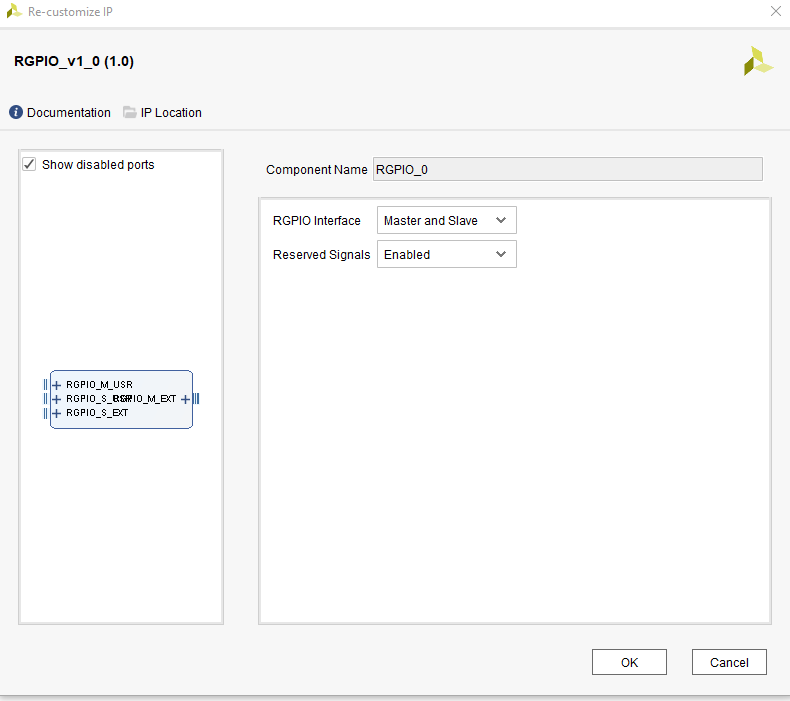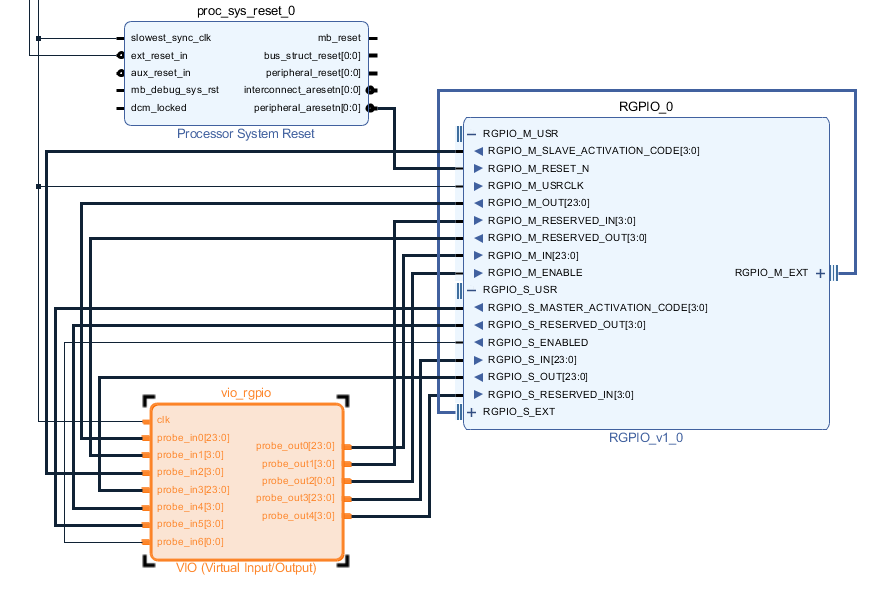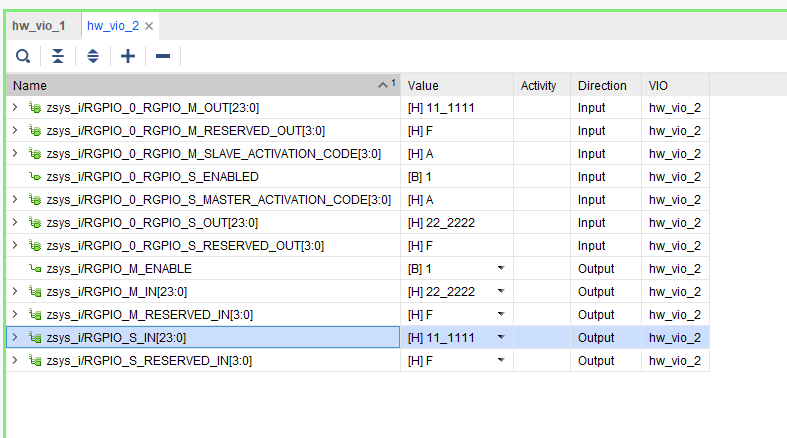Table of Contents
IP Facts
Introduction
This Trenz Electronic teCORE IP provides a RGPIO (Remote GPIO) Interface to talk to external RGPIO Devices. Convert parallel data bus into 3 wire signal and back to parallel data bus.
IP can be used as Master communicate with external RGPIO devices with Slave interface or as Slave to communicate with external RGPIO devices with Master interface.
Features
- Master RGPIO
- Slave RGPIO
- GPIO Expander
| teCORE™ IP Facts Table | |
|---|---|
| Supported Device Family | UltrasScale+ Zynq, 7 Series Zynq,UltraScale+ Series, UltraScale Series, 7 Series |
| Supported User Interfaces | Custom |
| Resources | |
| Special Features | RGPIO Master and Slave Controller |
| Provided with Core | |
| Design Files | VHDL Source Code |
| Constraint Files | Not provided, depends on module PCB |
| Example Design | Not Provided |
| Test Bench | Not Provided |
| Simulation Model | Not Provided |
| Supported S/W Dirver | Not Provided |
| Tested Design Flows | |
| Design Entry | Vivado® Design Suite, IP Integrator |
| Simulation | Vivado Simulator |
| Synthesis | Vivado Synthesis |
| Tested Hardware Platforms | |
| Support | |
| Provided by Trenz Electronic GmbH | |
Overview
This Trenz Electronic teCORE IP provides a RGPIO (Remote GPIO) Interface to talk to external RGPIO Devices over 3 wire
IP can be used as Master communicate with external RGPIO devices with Slave interface or as Slave communicate with external RGPIO devices with Master interface
Feature Summary
- Master RGPIO
- Slave RGPIO
Licensing and Ordering Information
This Trenz Electronic teCORE is licensed under MIT License. This IP is included in various Reference Designs or contact Trenz Electronic Support (support[at]trenz-electronic.de) with subject line "[TE-IP-Core Request]" to order this IP-Core.
Product Specification
Performance
Maximum RGPIO output CLK depends on Master and Slave device implementation. In the most cases maximum frequency of 25MHz is allowed.
Resource Utilization
Port Description
RGPIO_EXT External Interface
Communication channel between master and slave interface.
| Port Name | IO | Description |
|---|---|---|
| RGPIO_M_CLK | out | RGPIO Master Clock |
| RGPIO_M_RX | in | RGPIO Master RXD |
| RGPIO_M_TX | out | RGPIO Master TXD |
| Port Name | IO | Description |
|---|---|---|
| RGPIO_S_CLK | out | RGPIO Slave Clock |
| RGPIO_S_RX | in | RGPIO Slave RXD |
| RGPIO_S_TX | out | RGPIO Slave TXD |
RGPIO_M_USR Interface
Master user interface to communicate with slave device.
| Port Name | IO | Description |
|---|---|---|
| RGPIO_M_OUT | out | 23bit data output to slave device* |
| RGPIO_M_IN | in | 23bit data input from slave device* |
| RGPIO_M_RESERVED_OUT | out | 4bit reserved for future usage |
| RGPIO_M_RESERVED_IN | in | 4bit reserved for future usage |
| RGPIO_M_SLAVE_ACTIVATION_CODE | out | 4bit activation code from external slave for information only |
| RGPIO_M_ENABLE | in | Enable RGPIO communication. High active. Set RGPIO data as valid for Slave. Data will always transmitted, if CLK is available. |
| RGPIO_M_USRCLK | in | RGPIO transmission CLK for master and slave |
| RGPIO_M_RESET_N | in | RGPIO Reset. Low active. |
*currently limited to 23 bit to use IP with CPLD implementations of TE Boards. For general usage, this restriction will be removed on future IP update.
RGPIO_S_USR Interface
Slave user interface to communicate with master device.
| Port Name | IO | Description |
|---|---|---|
| RGPIO_S_OUT | out | 23bit data output to master device* |
| RGPIO_S_IN | in | 23bit data input from master device* |
| RGPIO_S_RESERVED_OUT | out | 4bit reserved for future usage |
| RGPIO_S_RESERVED_IN | in | 4bit reserved for future usage |
| RGPIO_S_MASTER_ACTIVATION_CODE | out | 4bit activation code from external master for information only |
| RGPIO_S_ENABLED | out | Interface status. Indicates RGPIO data are valid. |
*currently limited to 23 bit to use IP with CPLD implementations of TE Boards. For general usage, this restriction will be removed on future IP update.
Designing with the Core
This chapter includes guidelines and additional information to facilitate designing with the core.
Design Flow Steps
This chapter describes customizing and generating the core, constraining the core, and the simulation, synthesis and implementation steps that are specific to this IP core. More detailed information about the standard Vivado® design flows and the Vivado IP integrator can be found in the following Vivado Design Suite user guides:
- Vivado Design Suite User Guide: Designing IP Subsystems using IP Integrator (UG994)
- Vivado Design Suite User Guide: Designing with IP (UG896)
- Vivado Design Suite User Guide: Getting Started (UG910)
Customizing and Generating the Core
This section includes information about using Xilinx® tools to customize and generate the core in the Vivado Design Suite.
- RGPIO Interface: Master, Slave or both are possible
- Reserved Signals: Active/Deactivate reserved signals as interface
Constraining the Core
This section contains information about constraining the core in the Vivado Design Suite.
Required Constraints
Loc constrains and IO Standard depends on module and usage.
Device, Package, and Speed Grade Selections
This section is not applicable for this IP core.
Clock Frequencies
Maximum RGPIO output CLK depends on Master and Slave device implementation. In the most cases maximum frequency of 25MHz is always allowed.
Clock Management
This section is not applicable for this IP core.
Clock Placement
This section is not applicable for this IP core.
Banking
This section is not applicable for this IP core.
Transceiver Placement
This section is not applicable for this IP core.
I/O Standard and Placement
This section is not applicable for this IP core.
Simulation
This core does not support simulation.
Synthesis and Implementation
This section contains information about synthesis and implementation in the Vivado Design Suite. For details about synthesis and implementation, see the Vivado Design Suite User Guide:
- Designing with IP (UG896)
Example Design
There is no example Design for this IP core release.
Use Master Slave loopback over RGPIO_EXT interface to test IP Master and Slave Interface together.
Vivado Block Design:
VIO HW Manager:
Test Bench
There is no test bench for this IP core release.
Appx. A: Change History and Legal Notices
Document Change History
| Date | Document Revision | IP Revision | Authors | Description |
|---|---|---|---|---|
| v1.0 |
|
Legal Notices
Data Privacy
Please also note our data protection declaration at https://www.trenz-electronic.de/en/Data-protection-Privacy
Document Warranty
The material contained in this document is provided “as is” and is subject to being changed at any time without notice. Trenz Electronic does not warrant the accuracy and completeness of the materials in this document. Further, to the maximum extent permitted by applicable law, Trenz Electronic disclaims all warranties, either express or implied, with regard to this document and any information contained herein, including but not limited to the implied warranties of merchantability, fitness for a particular purpose or non infringement of intellectual property. Trenz Electronic shall not be liable for errors or for incidental or consequential damages in connection with the furnishing, use, or performance of this document or of any information contained herein.
Limitation of Liability
In no event will Trenz Electronic, its suppliers, or other third parties mentioned in this document be liable for any damages whatsoever (including, without limitation, those resulting from lost profits, lost data or business interruption) arising out of the use, inability to use, or the results of use of this document, any documents linked to this document, or the materials or information contained at any or all such documents. If your use of the materials or information from this document results in the need for servicing, repair or correction of equipment or data, you assume all costs thereof.
Copyright Notice
No part of this manual may be reproduced in any form or by any means (including electronic storage and retrieval or translation into a foreign language) without prior agreement and written consent from Trenz Electronic.
Technology Licenses
The hardware / firmware / software described in this document are furnished under a license and may be used /modified / copied only in accordance with the terms of such license.
Environmental Protection
To confront directly with the responsibility toward the environment, the global community and eventually also oneself. Such a resolution should be integral part not only of everybody's life. Also enterprises shall be conscious of their social responsibility and contribute to the preservation of our common living space. That is why Trenz Electronic invests in the protection of our Environment.


